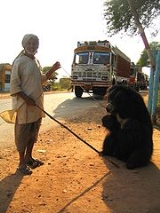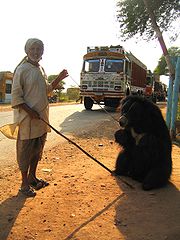
Tame bear
Encyclopedia

Bear
Bears are mammals of the family Ursidae. Bears are classified as caniforms, or doglike carnivorans, with the pinnipeds being their closest living relatives. Although there are only eight living species of bear, they are widespread, appearing in a wide variety of habitats throughout the Northern...
that is captured when the animal is young, though some of them are born and bred in captivity. In some parts of the world, such as South Asia
South Asia
South Asia, also known as Southern Asia, is the southern region of the Asian continent, which comprises the sub-Himalayan countries and, for some authorities , also includes the adjoining countries to the west and the east...
and the Middle East
Middle East
The Middle East is a region that encompasses Western Asia and Northern Africa. It is often used as a synonym for Near East, in opposition to Far East...
, people still use them for road side tourist attraction
Tourist attraction
A tourist attraction is a place of interest where tourists visit, typically for its inherent or exhibited cultural value, historical significance, natural or built beauty, or amusement opportunities....
s.
History
There exists evidence of various peoples taming bears in the Indus Valley CivilizationIndus Valley Civilization
The Indus Valley Civilization was a Bronze Age civilization that was located in the northwestern region of the Indian subcontinent, consisting of what is now mainly modern-day Pakistan and northwest India...
. Statues of bears suggest that they used them for entertainment purposes. Romani have been known to tame bears since the Middle Ages
Middle Ages
The Middle Ages is a periodization of European history from the 5th century to the 15th century. The Middle Ages follows the fall of the Western Roman Empire in 476 and precedes the Early Modern Era. It is the middle period of a three-period division of Western history: Classic, Medieval and Modern...
up until the end of the 14th century. This practice continues in places such as India
India
India , officially the Republic of India , is a country in South Asia. It is the seventh-largest country by geographical area, the second-most populous country with over 1.2 billion people, and the most populous democracy in the world...
, Bulgaria
Bulgaria
Bulgaria , officially the Republic of Bulgaria , is a parliamentary democracy within a unitary constitutional republic in Southeast Europe. The country borders Romania to the north, Serbia and Macedonia to the west, Greece and Turkey to the south, as well as the Black Sea to the east...
, and Siberia
Siberia
Siberia is an extensive region constituting almost all of Northern Asia. Comprising the central and eastern portion of the Russian Federation, it was part of the Soviet Union from its beginning, as its predecessor states, the Tsardom of Russia and the Russian Empire, conquered it during the 16th...
. Their acts are criticised by some Westerners, especially animal rights
Animal rights
Animal rights, also known as animal liberation, is the idea that the most basic interests of non-human animals should be afforded the same consideration as the similar interests of human beings...
advocates such as PETA
Peta
Peta can refer to:* peta-, an SI prefix denoting a factor of 1015* Peta, Greece, a town in Greece* Peta, the Pāli word for a Preta, or hungry ghost in Buddhism* Peta Wilson, an Australian actress and model* Peta Todd, English glamour model...
India
Indian gypsies poach Sloth BearSloth Bear
The sloth bear , also known as the labiated bear, is a nocturnal insectivorous species of bear found wild within the Indian subcontinent. The sloth bear evolved from ancestral brown bears during the Pleistocene and shares features found in insect-eating mammals through convergent evolution...
cubs from jungles and train them to dance for people. They would put a nose ring
Nose ring (animals)
A nose ring is a ring made of metal designed to be installed through the nasal septum of domestic cattle, usually bulls. Nose rings are often required for bulls when exhibited at agricultural shows. There also is a clip-on ring design used for controlling other cattle for showing or handling...
and a metal muzzle
Muzzle (device)
A muzzle is a device that is placed over the snout of an animal to keep it from biting or otherwise opening its mouth.An Elizabethan collar is a cone-shaped device placed around an animal's neck to prevent biting and sometimes referred to as a muzzle, though its function is more usually to prevent...
on the bear's snout, which are attached to a staff. The staff is then used to manipulate the bear, causing it to simulate a dance. Wildlife officers confiscated adult bears and cubs to send them to rescue centres located across India
India
India , officially the Republic of India , is a country in South Asia. It is the seventh-largest country by geographical area, the second-most populous country with over 1.2 billion people, and the most populous democracy in the world...
. The largest centre, which is open to the public, is in Agra. As of December 2009, officials have freed all of the remaining dancing bears.
The Middle East
Gypsies from Saudi ArabiaSaudi Arabia
The Kingdom of Saudi Arabia , commonly known in British English as Saudi Arabia and in Arabic as as-Sa‘ūdiyyah , is the largest state in Western Asia by land area, constituting the bulk of the Arabian Peninsula, and the second-largest in the Arab World...
poached Syrian Brown Bear
Syrian Brown Bear
The Syrian brown bear is a relatively small subspecies of brown bear native to Eurasia.- Distribution :Within the former Soviet Union, it occurs in Transcaucasia, Talysh, Northern Armenia, Abkhazia, Karabakh and Kopet Dag. Outside the ex-USSR, it occurs in Iran, Iraq and Turkey...
cubs from mountainous regions of Syria
Syria
Syria , officially the Syrian Arab Republic , is a country in Western Asia, bordering Lebanon and the Mediterranean Sea to the West, Turkey to the north, Iraq to the east, Jordan to the south, and Israel to the southwest....
, Turkey
Turkey
Turkey , known officially as the Republic of Turkey , is a Eurasian country located in Western Asia and in East Thrace in Southeastern Europe...
, Afghanistan
Afghanistan
Afghanistan , officially the Islamic Republic of Afghanistan, is a landlocked country located in the centre of Asia, forming South Asia, Central Asia and the Middle East. With a population of about 29 million, it has an area of , making it the 42nd most populous and 41st largest nation in the world...
, Iran
Iran
Iran , officially the Islamic Republic of Iran , is a country in Southern and Western Asia. The name "Iran" has been in use natively since the Sassanian era and came into use internationally in 1935, before which the country was known to the Western world as Persia...
, and Iraq
Iraq
Iraq ; officially the Republic of Iraq is a country in Western Asia spanning most of the northwestern end of the Zagros mountain range, the eastern part of the Syrian Desert and the northern part of the Arabian Desert....
. The tradition ended because of Islam
Islam
Islam . The most common are and . : Arabic pronunciation varies regionally. The first vowel ranges from ~~. The second vowel ranges from ~~~...
ic custom and belief.
Siberia
SiberiaSiberia
Siberia is an extensive region constituting almost all of Northern Asia. Comprising the central and eastern portion of the Russian Federation, it was part of the Soviet Union from its beginning, as its predecessor states, the Tsardom of Russia and the Russian Empire, conquered it during the 16th...
n tribal peoples capture cubs for use as dancing bears. This practice continues to this day.
Europe
Dancing bears were a common sight in EuropeEurope
Europe is, by convention, one of the world's seven continents. Comprising the westernmost peninsula of Eurasia, Europe is generally 'divided' from Asia to its east by the watershed divides of the Ural and Caucasus Mountains, the Ural River, the Caspian and Black Seas, and the waterways connecting...
during the Middle Ages
Middle Ages
The Middle Ages is a periodization of European history from the 5th century to the 15th century. The Middle Ages follows the fall of the Western Roman Empire in 476 and precedes the Early Modern Era. It is the middle period of a three-period division of Western history: Classic, Medieval and Modern...
. All of Europe had dancing bears during the 13th century. The practice began fading in Western Europe by the 15th century, but remained alive in Eastern Europe. Dancing bears were commonly seen in Bern, Switzerland. The depiction of a dancing bear occurs in the oldest known city seal (1224), and living bears have been kept in Bern at the town's expense since 1513 (except for a brief interval when the French removed them to Paris in 1799.5). Dancing bears were also a common feature at traditional winter festivals in Poland throughout the 18th century.
External links
- http://www.wildlifesos.org/IBR/ABRF/ABRF.htm Agra Bear Rescue Facility
- http://www.internationalanimalrescue.org/projects/9/Bear+rescue+and+rehabilitation.html Dancing bear rescue and rehabilitation
- http://www.wspa-usa.org/pages/2171_dancing_bears.cfm
- http://blip.tv/file/3282941 Video footage about the last dancing bear in Bulgaria

